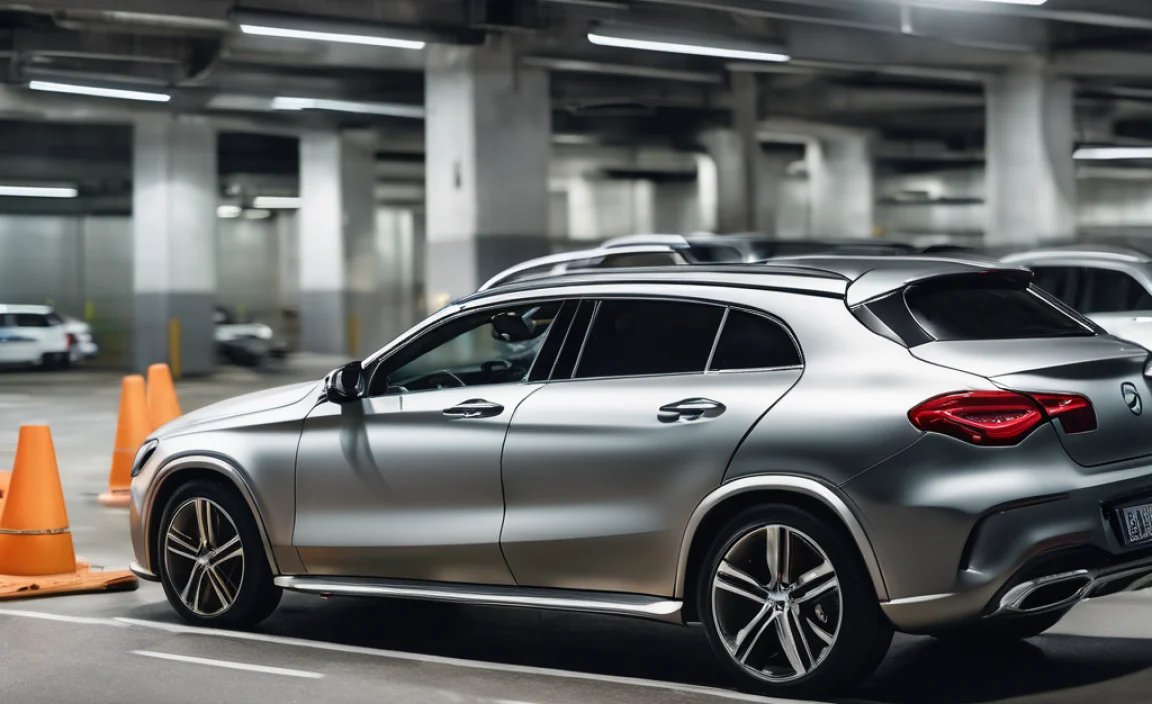The Mercedes-Benz GLA-Class parking assist system makes parking simple, guiding you into tight spots with less stress. This guide explains how to use it effectively for effortless maneuvering in any parking situation, ensuring you can park with confidence every time.
Parking can sometimes feel like a high-stakes game, especially in busy city streets or cramped parking garages. The good news is, your Mercedes-Benz GLA-Class is equipped with smart technology designed to take the guesswork out of parking. Parking assist features help you navigate tight spaces with precision and ease, reducing the stress and potential for minor bumps. Let’s dive into how you can make the most of these helpful systems, turning parking from a chore into a simple, confident maneuver.
Understanding Your GLA-Class Parking Assist Options

Mercedes-Benz offers various parking assistance technologies, and your GLA-Class likely features one or more of these. The core idea behind them is to use sensors and cameras to detect available parking spaces and then steer the vehicle into them, often with minimal input from you. Understanding what each system does is the first step to using it effectively.
Active Park Assist
This is the most sophisticated parking system available for the GLA-Class. It can actively steer the vehicle into parallel and sometimes perpendicular parking spots. When activated, it scans for suitable spaces as you drive by. Once a space is identified, the system will alert you and offer to take over the steering. You’ll still be responsible for controlling the accelerator, brake, and gear selection, but the system handles the tricky steering part for you.
Parking Sensors (PARKTRONIC)
Even if your GLA-Class doesn’t have the full Active Park Assist, it almost certainly comes with PARKTRONIC parking sensors. These are small, discreet sensors located in the front and rear bumpers. They use ultrasonic waves to detect obstacles around the vehicle. As you get closer to an object, the sensors emit audible beeps that increase in frequency. More advanced systems also display a visual guide on the infotainment screen, showing you how close you are to objects.
Reversing Camera (Rear View Camera)
A standard feature on most modern GLA-Class models, the reversing camera provides a visual feed of what’s behind your car on the central display. This camera often includes dynamic guide lines that move with your steering wheel, showing you the projected path of your vehicle. This is incredibly useful for judging distances and avoiding obstacles when reversing.
360° Camera System (Surround View System)
For ultimate visibility, some GLA-Class models can be equipped with a 360° camera system. This system uses multiple cameras mounted on the exterior of the vehicle (side mirrors, front grille, rear) to create a bird’s-eye view of your surroundings. This stitched-together image on your display gives you an unparalleled perspective, making it much easier to navigate very tight spaces and understand the vehicle’s position relative to all obstacles.
How to Activate and Use Active Park Assist

Active Park Assist is designed to simplify parallel and, in some cases, perpendicular parking. It’s an excellent tool for drivers who want an extra hand when maneuvering into challenging spots.
Step-by-Step Guide to Using Active Park Assist:
- Engage the System: With your vehicle moving at a slow speed (typically below 19 mph or 30 km/h), activate the PARKTRONIC system. This is usually done via a button on the center console (often with a ‘P’ and an arrow symbol). Look for the PARKTRONIC indicator light on the dashboard or console to confirm it’s active.
- Scan for Parking Spaces: Drive slowly along the side of parked cars. The system will automatically scan the spaces for a suitable size. When a potential spot is detected, an icon will appear on your infotainment screen, along with the message “Parking space found.”
- Select the Space: The system will typically highlight a few detected spaces. Use the steering wheel controls or the touchscreen to select the space you want to park in. The display will prompt you on which side to position your vehicle (usually the driver’s side for parallel parking).
- Initiate Parking: Once you’ve selected the space, follow the on-screen instructions. The system will tell you when to stop and the gear to select (usually Reverse ‘R’ for parallel parking, or Drive ‘D’ for perpendicular parking).
- Control Acceleration and Braking: This is where you take over crucial control. The Active Park Assist will automatically steer the vehicle into the parking spot. It is your responsibility to control the accelerator and brake pedals. Gently press the brake or accelerator as needed to control the speed of the maneuver. You should always be ready to apply the brakes firmly if necessary. Always keep your foot near the brake pedal!
- Monitor the Maneuver: Watch the infotainment screen carefully. It will display the vehicle’s progress and often a visual representation of the parking maneuver. The system will indicate when the parking maneuver is complete.
- Disengage the System: Once parked, the system will notify you that it has finished. You can then gently disengage the system by turning the steering wheel yourself or by pressing the PARKTRONIC button again.
Important Considerations for Active Park Assist:
- Speed is Key: Ensure you are driving slowly, as prescribed by the system’s guidance, for it to accurately detect and maneuver into spaces.
- Clearance: The system needs adequate space to maneuver. Don’t assume it can squeeze into impossibly tight spots.
- Driver Supervision: Remember, you are still in control of the vehicle’s speed and must be prepared to intervene at any moment.
- Surface Conditions: The system works best on relatively level surfaces.
Maximizing the Use of PARKTRONIC Parking Sensors

PARKTRONIC sensors are your first line of defense against minor bumps and scrapes. They provide crucial proximity warnings long before you might see an obstacle with your eyes alone.
How PARKTRONIC Works:
The sensors emit ultrasonic sound waves. When these waves hit an object, they bounce back to the sensor. The system calculates the time it takes for the sound wave to return, determining the distance to the object. This information is then translated into audible beeps and sometimes visual cues.
Understanding the Beep System:
The pattern of the beeps is your guide:
- Intermittent, slow beeps: You are at a safe distance from an obstacle.
- Intermittent, faster beeps: You are getting closer.
- Continuous, steady beep: You are very close. Stop immediately!
The visual display usually corresponds with these audio cues. You’ll see colored bars or indicators on your dashboard or infotainment screen that illuminate to show which sensor has detected an object and how close it is.
Tips for Using PARKTRONIC Effectively:
- Always Listen: Even with a rear-view camera, don’t solely rely on visuals. The audible alerts from the sensors are invaluable, especially in situations where your view might be obstructed.
- Know Your Zones: Familiarize yourself with where the sensors are located on your GLA-Class’s bumpers. This helps you understand which direction the warning is coming from.
- Keep Sensors Clean: Dirt, snow, ice, or mud can block the sensors, impairing their performance. Regularly clean them with a soft cloth and mild soap and water. Avoid abrasive cleaners.
- Adapt to Conditions: In heavy rain or snow, the sensors might give false warnings. They can also be temporarily affected by loud noises or extreme weather. Be a little more cautious in such conditions and rely more on your direct vision.
Leveraging Your GLA-Class Reversing Camera

The reversing camera is a fantastic visual aid. It gives you a clear view of what’s directly behind your vehicle, making it so much easier to back into parking spaces or navigate out of tight driveways.
Essential Features of the Reversing Camera:
- Wide-Angle View: Most reversing cameras provide a wide-angle view, showing you a broad section of the area behind your car.
- Dynamic Guide Lines: These are the lines on the screen that show your projected path. They usually curve to indicate where your wheels will go as you turn the steering wheel. This is incredibly helpful for precise maneuvering.
- Obstacle Highlighting (with PARKTRONIC): If your GLA-Class has both a reversing camera and PARKTRONIC sensors, the camera display often integrates the sensor warnings. You’ll see colored indicators on the screen corresponding to the beeps from the sensors.
Best Practices for Using Your Reversing Camera:
- Always Check the Screen: As soon as you shift into reverse, glance at the screen. Get familiar with the view and the guide lines.
- Understand the Guide Lines: Practice in an open area to understand how the guide lines correspond to your vehicle’s actual path. The red line usually indicates where the bumper will end up, so aim to stop when your target obstacle is just beyond it.
- Don’t Rely Solely on the Camera: While incredibly useful, the camera has blind spots. Always turn your head to physically check your surroundings, especially for low-lying objects or rapidly approaching traffic. The camera is an aid, not a replacement for situational awareness.
- Keep It Clean: Like parking sensors, the camera lens should be kept clean. It’s usually located near the trunk handle or license plate light. A quick wipe with a microfiber cloth can make a big difference.
The Power of the 360° Camera System (Surround View)

For the ultimate parking confidence, the 360° camera system is a game-changer. It stitches together images from multiple cameras to give you a seamless, overhead view of your GLA-Class and its immediate surroundings.
How the 360° Camera System Enhances Parking:
This system simulates a bird’s-eye view, as if a camera were hovering directly above your car. It’s invaluable for:
- Tight Parking Spots: Maneuvering between two cars with only inches to spare becomes much less daunting.
- Navigating Complex Areas: It helps you avoid scraping wheels on curbs or hitting low-lying obstacles in driveways or parking garages.
- Perpendicular Parking: Gauging your distance from the lines or other cars on either side is significantly easier.
Using the 360° Camera System:
- Activate: The system typically activates automatically when you shift into reverse. You might also be able to activate it manually via a button on the center console or by accessing it through the infotainment system menu.
- Select Views: Your display will likely show a combined 360° view. You can often tap on the screen or use controls to zoom in on specific camera views (e.g., front, rear, sides) or toggle between different perspectives.
- Integrate with Other Aids: The 360° view often incorporates the dynamic guide lines from the reversing camera and can be combined with PARKTRONIC sensor warnings for comprehensive situational awareness.
- Practice Makes Perfect: While intuitive, it’s wise to practice using the 360° camera in less stressful environments to get fully comfortable with the different views and how they relate to your vehicle’s position.
Parking Assist System Maintenance and Troubleshooting
Like any advanced technology, parking assist systems require a little care to function optimally. Most issues are minor and easily resolved.
Common Issues and Solutions:
| Symptom | Possible Cause | Troubleshooting Steps |
|---|---|---|
| Parking assists unavailable / system error message | Sensors are blocked or dirty. | Clean all parking sensors and camera lenses thoroughly with a soft, damp cloth. |
| Inaccurate readings or no beeps from sensors | Dirt, snow, ice, or damage to sensors. | Ensure sensors are clean. Check for visible K24 damage. If damage is present, professional inspection is needed. |
| Reversing camera not displaying image | Camera lens is dirty or blocked. System glitch. | Clean the camera lens. Try restarting the vehicle. If the issue persists, a diagnostic check might be required. |
| Active Park Assist not finding spaces or not activating | Driving too fast. Space is too small or incorrectly positioned. System is switched off. | Ensure you are driving slowly (below 19 mph / 30 km/h). Double-check that the space is large enough. Verify that the PARKTRONIC button is engaged. |
| Intermittent or false warnings | Extreme weather (heavy rain, snow). Close proximity to metallic objects or other vehicles. | Be extra vigilant in these conditions and rely more on direct observation. These systems are aids, not infallible guides. |
When to Seek Professional Help:
If you’ve cleaned the sensors and cameras, ensured the system is activated, and are still encountering persistent errors or malfunctions, it’s time to consult a Mercedes-Benz service center. Damage to sensors or wiring, or more complex electronic issues, will require specialized tools and expertise to diagnose and repair. You can find authorized service centers through the official Mercedes-Benz USA website or your local dealer’s site.
Tips for Safe and Effective Parking Maneuvers
While parking assist systems significantly enhance your capabilities, they are most effective when used in conjunction with good driving practices. Safety should always be your top priority.
General Parking Safety Tips:
- Situational Awareness is Paramount: Always look around your vehicle and check blind spots before, during, and after parking maneuvers. Your eyes are your most crucial tool.
- Understand Your Vehicle’s Dimensions: Get to know the size of your GLA-Class. This helps you judge spaces even without assistance.
- Practice Makes Perfect: Use empty parking lots at quiet times to practice using the parking assist systems. This helps you build confidence and understand how they work.
- Be Patient: Rushing a parking maneuver, even with assistance, increases the risk of error. Take your time.
- Know When Not to Use Assist: If conditions are extremely poor, or if you feel uncomfortable with the system’s performance, it’s perfectly acceptable to disengage it and park manually.
- Maintain Your Vehicle: Regular maintenance ensures all systems, including parking aids, are functioning correctly.
- Check Official Guidelines: For precise operational details and limitations specific to your GLA-Class model year, always refer to your owner’s manual. It provides manufacturer-approved information on how to use each feature safely and effectively.
Frequently Asked Questions (FAQ) about GLA-Class Parking Assist
Q1: Does the GLA-Class parking assist park the car entirely on its own?
A1: The most advanced system, Active Park Assist, steers the car into the space. However, you are responsible for controlling the accelerator, brake, and gear shifter. It’s a semi-autonomous parking system that requires your supervision.
Q2: How far away from a parking spot should I be for the Active Park Assist to detect it?
A2: The system typically scans for spaces as you drive by at slow speeds (usually under 19 mph or 30 km/h). It needs to be able to “see” the parallel space next to other cars. Drive parallel to parking spots and wait for the on-screen notification.
Q3: Can PARKTRONIC sensors detect curbs or very low obstacles?
A3: PARKTRONIC sensors are primarily designed to detect rigid objects at various heights. However, very low curbs or obstacles might be missed, especially if they are close to the ground or made of soft material. Always combine sensor alerts with visual checks.
Q4: My reversing camera isn’t working. What should I do?
A4: First, check if the camera lens is clean. Dirt or debris can obstruct the view. If it’s clean, try restarting your vehicle. If the problem persists, it might be an electrical issue or a fault with the camera itself, requiring professional diagnosis.
Q5: How often should I clean the parking sensors and cameras?
A5: It’s a good practice to clean them whenever you wash your car, or whenever they appear dirty. Pay special attention during winter months when snow, ice, and road salt can accumulate.
Q6: Can the parking assist systems be used in bad weather like heavy rain or snow?
A6: While the systems can function in most weather, heavy rain, snow, or fog can sometimes interfere with sensor accuracy or camera clarity. In such conditions, be extra cautious and rely more on your direct visual observation and judgment.
Q7: What’s the difference between Parking Assist Package